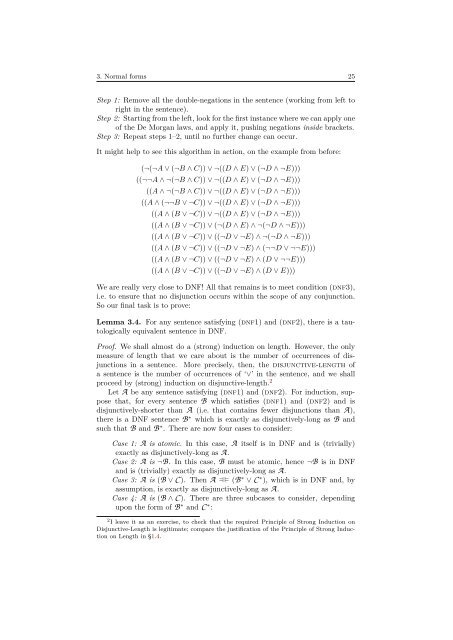Metatheory - University of Cambridge
Metatheory - University of Cambridge
Metatheory - University of Cambridge
You also want an ePaper? Increase the reach of your titles
YUMPU automatically turns print PDFs into web optimized ePapers that Google loves.
3. Normal forms 25<br />
Step 1: Remove all the double-negations in the sentence (working from left to<br />
right in the sentence).<br />
Step 2: Starting from the left, look for the first instance where we can apply one<br />
<strong>of</strong> the De Morgan laws, and apply it, pushing negations inside brackets.<br />
Step 3: Repeat steps 1–2, until no further change can occur.<br />
It might help to see this algorithm in action, on the example from before:<br />
(¬(¬A ∨ (¬B ∧ C)) ∨ ¬((D ∧ E) ∨ (¬D ∧ ¬E)))<br />
((¬¬A ∧ ¬(¬B ∧ C)) ∨ ¬((D ∧ E) ∨ (¬D ∧ ¬E)))<br />
((A ∧ ¬(¬B ∧ C)) ∨ ¬((D ∧ E) ∨ (¬D ∧ ¬E)))<br />
((A ∧ (¬¬B ∨ ¬C)) ∨ ¬((D ∧ E) ∨ (¬D ∧ ¬E)))<br />
((A ∧ (B ∨ ¬C)) ∨ ¬((D ∧ E) ∨ (¬D ∧ ¬E)))<br />
((A ∧ (B ∨ ¬C)) ∨ (¬(D ∧ E) ∧ ¬(¬D ∧ ¬E)))<br />
((A ∧ (B ∨ ¬C)) ∨ ((¬D ∨ ¬E) ∧ ¬(¬D ∧ ¬E)))<br />
((A ∧ (B ∨ ¬C)) ∨ ((¬D ∨ ¬E) ∧ (¬¬D ∨ ¬¬E)))<br />
((A ∧ (B ∨ ¬C)) ∨ ((¬D ∨ ¬E) ∧ (D ∨ ¬¬E)))<br />
((A ∧ (B ∨ ¬C)) ∨ ((¬D ∨ ¬E) ∧ (D ∨ E)))<br />
We are really very close to DNF! All that remains is to meet condition (dnf3),<br />
i.e. to ensure that no disjunction occurs within the scope <strong>of</strong> any conjunction.<br />
So our final task is to prove:<br />
Lemma 3.4. For any sentence satisfying (dnf1) and (dnf2), there is a tautologically<br />
equivalent sentence in DNF.<br />
Pro<strong>of</strong>. We shall almost do a (strong) induction on length. However, the only<br />
measure <strong>of</strong> length that we care about is the number <strong>of</strong> occurrences <strong>of</strong> disjunctions<br />
in a sentence. More precisely, then, the disjunctive-length <strong>of</strong><br />
a sentence is the number <strong>of</strong> occurrences <strong>of</strong> ‘∨’ in the sentence, and we shall<br />
proceed by (strong) induction on disjunctive-length. 2<br />
Let A be any sentence satisfying (dnf1) and (dnf2). For induction, suppose<br />
that, for every sentence B which satisfies (dnf1) and (dnf2) and is<br />
disjunctively-shorter than A (i.e. that contains fewer disjunctions than A),<br />
there is a DNF sentence B ∗ which is exactly as disjunctively-long as B and<br />
such that B and B ∗ . There are now four cases to consider:<br />
Case 1: A is atomic. In this case, A itself is in DNF and is (trivially)<br />
exactly as disjunctively-long as A.<br />
Case 2: A is ¬B. In this case, B must be atomic, hence ¬B is in DNF<br />
and is (trivially) exactly as disjunctively-long as A.<br />
Case 3: A is (B ∨ C ). Then A ⊨ (B ∗ ∨ C ∗ ), which is in DNF and, by<br />
assumption, is exactly as disjunctively-long as A.<br />
Case 4: A is (B ∧ C ). There are three subcases to consider, depending<br />
upon the form <strong>of</strong> B ∗ and C ∗ :<br />
⊨<br />
2 I leave it as an exercise, to check that the required Principle <strong>of</strong> Strong Induction on<br />
Disjunctive-Length is legitimate; compare the justification <strong>of</strong> the Principle <strong>of</strong> Strong Induction<br />
on Length in §1.4.
















